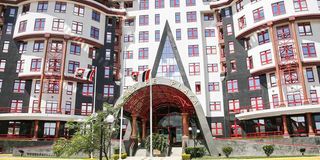From oil to water: Kenya Pipeline Company sees new use for its old pipeline

The Kenya Pipeline Company's head office in Nairobi. KPC has revived its plans to repurpose its decommissioned Mombasa-Nairobi oil pipeline to pump water to the coastal city.
The Kenya Pipeline Company (KPC) has revived its plans to repurpose its decommissioned Mombasa-Nairobi oil pipeline to pump water to the coastal city.
KPC stopped using the 14-inch 450-kilometre pipeline, known as Line 1, in December 2020 after building a new, larger capacity pipeline.
Line 1 was, at the time, Kenya’s oldest pipeline that was used for 42 years after it was built in 1978 to transport gasoline, kerosene, Jet A-1, and diesel from Mombasa to the hinterland.
The age of the pipeline, which had a maximum flow rate of 880 cubic metres per hour, led to frequent leakages of fuel due to corrosion. This in turn led to massive losses as well as increased maintenance costs.
After it was decommissioned, KPC mulled disposing of the entire pipeline as scrap or abandoning the infrastructure underground but later decided to remodel it to transport water.
The company will be implementing the project together with the Coast Water Works Development Agency.
KPC says it will remove and dispose of the section of the old pipeline that stretched from Mtito Andei to Nairobi.
It will also extract the section from Ndii to Mtito Andei and reuse the line between Ndii and Mzima Springs located within the Tsavo National Park at the foot of Chyulu Hills.
Mzima Springs water flow
This will allow water to flow from Mzima Springs to Ndii and thereafter to Mombasa through the old pipeline
This is according to an Environmental and Social Impact Assessment (Esia) report for the project submitted to the National Environment Management Authority (Nema).
“The proposed decommissioning and potential reuse of Line 1 is a linear project with a total distance of 450 kilometres and passes through eight counties, namely: Mombasa, Kwale, Kilifi, Taita Taveta, Makueni, Kajiado, Machakos, and Nairobi,” said the energy firm.
Mzima Springs is the second largest source of water for the Coast region. Having been developed in 1957, the spring supplies some 35,000 cubic metres of water per day to the coastal region.
The Baricho Wellfield, developed in 1980, is the largest supplier of water in the region, with a capacity of 90,000 cubic meters while the Marere Springs and Tiwi Aquifer have a capacity of 12,000 and 13,000 cubic metres respectively.
KPC, in 2018, commissioned the new 20-inch pipeline called Line 5 ahead of the decommissioning of the old pipeline.
The new pipeline has a maximum flow rate of 1,000 cubic metres per hour.
Some 25 million litres of fuel, however, remained stuck in the old pipeline after the company stopped using it due to insufficient water to flush out the commodity.
The company in 2021 said it needed 41,600 cubic meters (41.6 million litres) of water to push out the diesel that was valued at Sh2.8 billion at the time.
KPC is exploring building a new pipeline in the place where Line 1 will be removed and alongside the old pipeline in stretches where it will not be removed.
“It is likely that KPC will either construct another white oil/gas pipeline or install other linear energy/communication infrastructure within the RoW (right of way) from Mombasa to Nairobi. This will require KPC to remove the retired line 1 and dispose of the old pipeline as scrap metal,” said the report.





